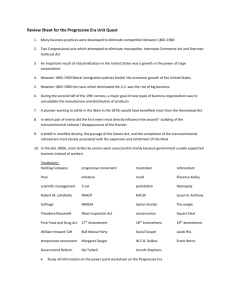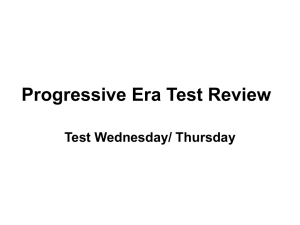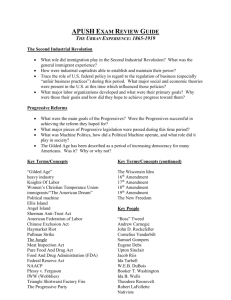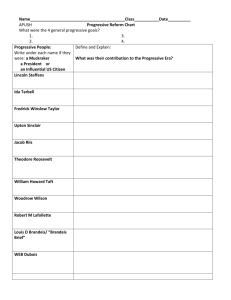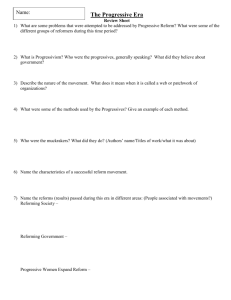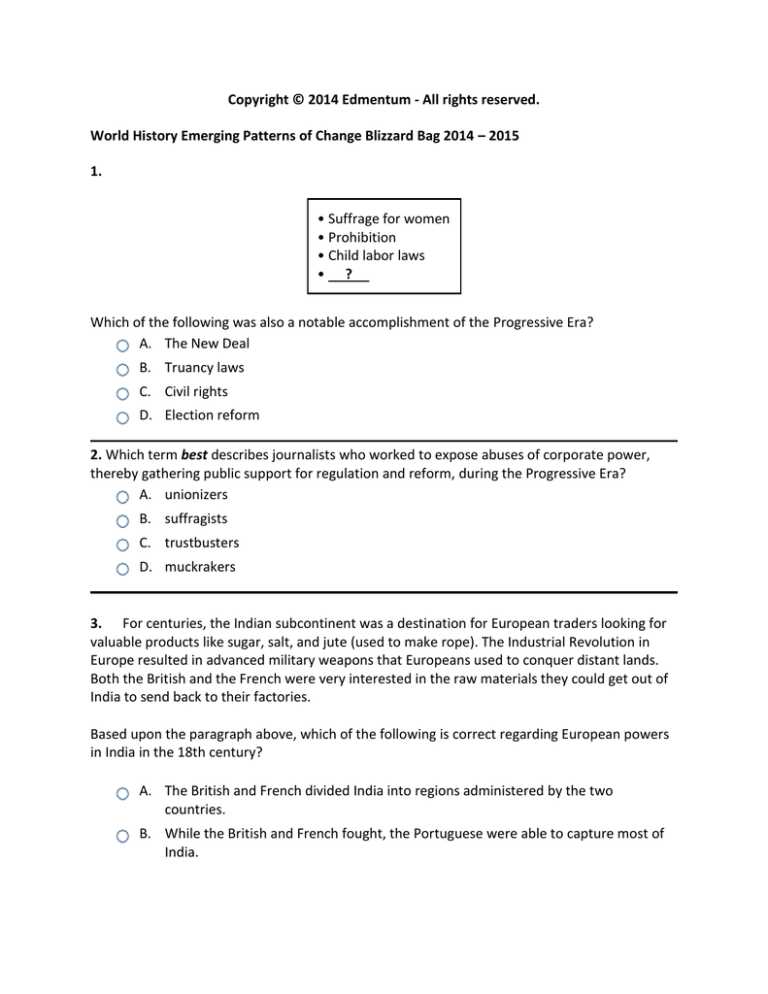
Copyright © 2014 Edmentum - All rights reserved.
World History Emerging Patterns of Change Blizzard Bag 2014 – 2015
1.
• Suffrage for women
• Prohibition
• Child labor laws
• ?
Which of the following was also a notable accomplishment of the Progressive Era?
A. The New Deal
B. Truancy laws
C. Civil rights
D. Election reform
2. Which term best describes journalists who worked to expose abuses of corporate power,
thereby gathering public support for regulation and reform, during the Progressive Era?
A. unionizers
B. suffragists
C. trustbusters
D. muckrakers
3. For centuries, the Indian subcontinent was a destination for European traders looking for
valuable products like sugar, salt, and jute (used to make rope). The Industrial Revolution in
Europe resulted in advanced military weapons that Europeans used to conquer distant lands.
Both the British and the French were very interested in the raw materials they could get out of
India to send back to their factories.
Based upon the paragraph above, which of the following is correct regarding European powers
in India in the 18th century?
A. The British and French divided India into regions administered by the two
countries.
B. While the British and French fought, the Portuguese were able to capture most of
India.
C. The French East India Company defeated the British and expanded into the Bengal
region.
D. The British and the French fought against each other for control of India.
4.
• Elected Prime Minister of Sardinia in 1852
• Instrumental to the Italian unification movement
• Founded the nationalist newspaper Il Risorgimento
Which of the following people is described above?
A. Camillo Cavour
B. Otto von Bismarck
C. Giuseppe Garibaldi
D. Giuseppe Mazzini
5. Which of the following statements best describes the role of the British East India Company
(the Company) in India in the early 1800s?
A. The Company signed a treaty with France to expand trade into the south.
B. The Company had no influence in areas not controlled by the British army.
C. The Company controlled foreign affairs and defense throughout most of India.
D. Great Britain controlled India and the Company was only involved in trade.
6. The Progressive Movement was characterized by
A. politically active farmers who were united by a platform to abandon the gold
standard for currency.
B. constant civil disobedience on the part of activists determined to secure equality
for African Americans.
C. the belief that the United States should involve itself more actively in foreign
affairs and become expansionist.
D. efforts to better American society through reform, expanded democracy, science,
and government regulation.
7. The Parliamentary Reform Act of 1832 focused on changes to the electoral system of the
United Kingdom. It expanded the number of people who were allowed to vote in England, but
specifically excluded
A. property-owning males.
B. women.
C. Whigs.
D. Tories.
8. Which is true about Progressive leader Jane Addams?
A. She established Hull House for poor immigrants in Chicago.
B. She fought against the Prohibition movement in the U.S.
C. She was the first female to serve on the U.S. Supreme Court.
D. She wrote the Universal Declaration of Human Rights.
9. Europe's influence spread rapidly throughout the 19th century as it colonized Africa and
Southeast Asia. Power and wealth were the driving forces in the search for raw materials to
send back to European factories to produce manufactured goods. Through industrialization and
the creation of strong nation-states, Europe was able to dominate the colonies and take
whatever they needed – raw materials, crops, or cheap labor. Many European countries
justified their actions by claiming that
A. they were preventing wars in the colonies by providing jobs and healthcare.
B. they were preventing people in colonies from immigrating to European cities.
C. the people in the colonies had the same rights and privileges as European citizens.
D. they were bringing the benefits of their superior civilization to savages.
10. What did the 16th Amendment accomplish?
A. It established an income tax.
B. It granted suffrage to women.
C. It prohibited the sale of alcohol.
D. It provided for the popular election of Senators.
11.
Which practice does the photo above show that Progressive leaders were trying to regulate?
A. indentured servitude
B. child labor
C. union organization
D. assembly lines
12. Which is one of the political reforms that Progressive leaders advocated?
A. They wanted to end the political corruption that existed in many cities.
B. They wanted to reduce the number of people who were eligible to vote.
C. They only wanted wealthy people to become politicians.
D. They wanted the voting age to be 18.
13. On March 25, 1911, a fire broke out at the Triangle Shirtwaist Factory in New York City. 146
garment workers died because they were unable to escape from the upper floors of the
building. What impact did this fire have on the garment industry?
A. Groups worked to end child labor.
B. Groups advocated safer working conditions for factory workers.
C. Groups lobbied for a national minimum wage.
D. Groups called for the break-up of unions.
14.
• Elected prime minister of Prussia in 1862
• Used policies of realpolitik to manipulate German politics
• First Chancellor of the German Empire in 1871
Which of the following people is described above?
A. Otto von Bismarck
B. Frederick the Great
C. Paul von Hindenburg
D. Wilhelm I
15. Which amendment resulted in U.S. senators being elected directly by the voting public?
A. the 19th Amendment
B. the 21st Amendment
C. the 18th Amendment
D. the 17th Amendment

